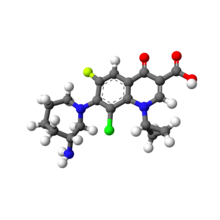Besifloxacin
 | |
 | |
| Clinical data | |
|---|---|
| Trade names | Besivance |
| AHFS/Drugs.com | Monograph |
| MedlinePlus | a610011 |
| License data |
|
| Routes of administration | Ophthalmic |
| ATC code | |
| Legal status | |
| Legal status |
|
| Identifiers | |
| |
JSmol) | |
| |
| |
Besifloxacin (
The eye drop was approved by the United States Food and Drug Administration (FDA) on May 29, 2009, and marketed under the trade name Besivance.[2]
Pharmacodynamics
Besifloxacin is a
Medical use
Besifloxacin is indicated in the treatment of bacterial conjunctivitis caused by sensitive bacteria,[5] as well as in the prevention of infectious complications in patients undergoing laser therapy for the treatment of cataracts.[6][7] It has been approved for use in children, adults, and the elderly, with clinically proven efficacy and safety from age one and older.[4]
Besifloxacin is available as a 0.6% ophthalmological suspension, and dosing is 3 times a day, 4 to 12 hours apart for 7 days, regardless of age or condition.[4]
Adverse effects
During the treatment, the most frequently reported ocular adverse reaction was the appearance of conjunctival redness (approximately 2% of patients). Other possible adverse reactions, reported in subjects treated with besifloxacin were: blurred vision, eye pain, eye irritation, eye pruritus and headache.[4]
References
- ^ "InSite Vision Reaches Agreement to Sell ISV-403 to Bausch & Lomb" (Press release). InSite Vision. 2003-12-19. Retrieved 2009-08-15.
- ^ "Bausch & Lomb Receives FDA Approval of Besivance, New Topical Ophthalmic Antibacterial for the Treatment of Bacterial Conjunctivitis ("Pink Eye")" (Press release). Bausch & Lomb. 2009-05-29. Archived from the original on 2009-06-01. Retrieved 2009-05-29.
- PMID 17965029.
- ^ a b c d "Besivance Full Prescribing Info" (PDF). Bausch & Lomb. 02-01-2022. Retrieved 07-29-2022.
- PMID 24142473.
- PMID 24637269.
- PMID 23355771.
